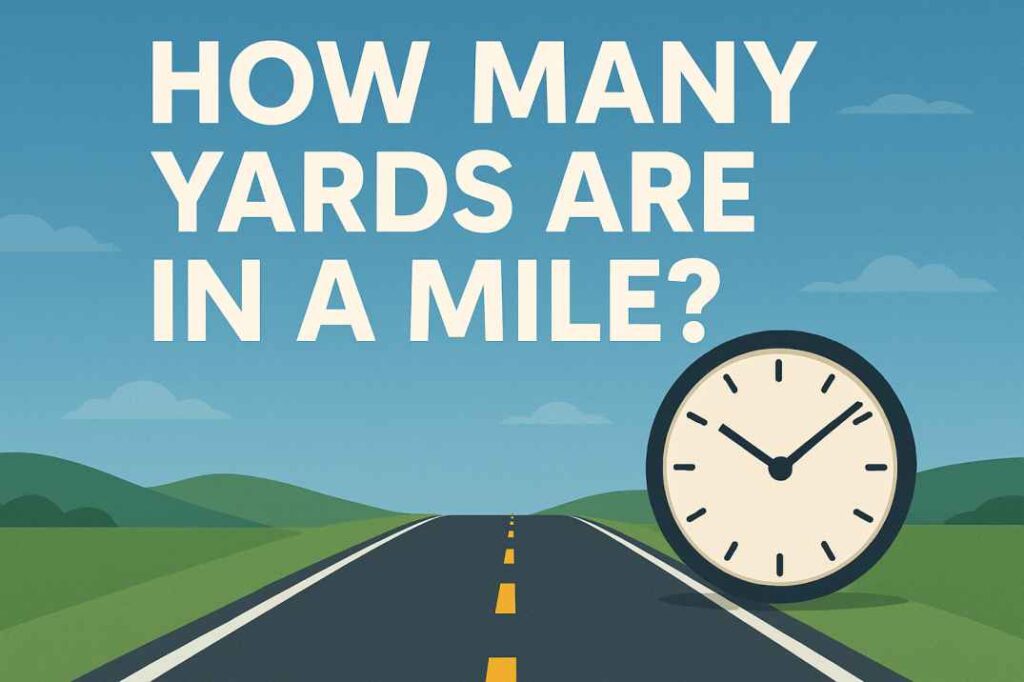When it comes to measuring distances, the mile is one of the most commonly used units in the United States and a few other countries that follow the Imperial system. However, to truly understand distances, it’s helpful to know how miles convert into smaller units such as yards. This article takes an in depth look at the relationship between miles and yards, including the historical origins, mathematical breakdowns, practical applications and visual aids to make the concept crystal clear.
What Is a Mile?
A mile is a unit of linear measurement used primarily in the United States and a few other countries. It is equal to:
- 1 mile = 1,760 yards
- 1 mile = 5,280 feet
- 1 mile ≈ 1.60934 kilometers
The term “mile” comes from the Latin phrase mille passus, which means “a thousand paces.” The Roman mile measured approximately 5,000 Roman feet or about 4,850 of today’s feet. Over time, standardization led to the modern mile of 5,280 feet.
What Is a Yard?
A yard is another unit of length in the Imperial system, defined as:
- 1 yard = 3 feet
- 1 yard = 36 inches
- 1 yard ≈ 0.9144 meters
The yard was historically based on the length of a man’s belt or girth and has varied over centuries. Today, it’s standardized and is commonly used in measuring shorter distances, especially in sports and construction.
The Conversion: How Many Yards in a Mile?
1 mile = 5,280 feet
1 yard = 3 feet
5280 feet ÷ 3 feet/yard = 1760 yards
So, 1 mile = 1,760 yards.
Conversion Table: Miles to Yards
| Miles | Yards |
|---|---|
| 0.25 | 440 |
| 0.5 | 880 |
| 0.75 | 1,320 |
| 1 | 1,760 |
| 1.5 | 2,640 |
| 2 | 3,520 |
| 3 | 5,280 |
| 5 | 8,800 |
This table is particularly useful when you’re trying to quickly convert common distances for things like running, driving, or construction work.
Chart: Visualizing the Conversion
Below is a chart that visually represents how yards increase in proportion to miles. This helps clarify just how steep the conversion is:
As you can see, the relationship is linear. Every additional mile adds exactly 1,760 yards.

Historical Context of the Mile and Yard
The development of standardized measurement systems is essential to modern infrastructure. Here’s a quick timeline of how these two units evolved:
| Year | Event |
|---|---|
| ~Roman Era | Introduction of the mille passus (roughly 5,000 Roman feet) |
| 1593 | England standardizes the statute mile at 5,280 feet |
| 18th century | Yard becomes commonly defined as 3 feet |
| 1959 | International yard standardized as exactly 0.9144 meters |
Read More: How Many Hours in a Week?
Practical Uses of the Mile-Yard Conversion
Understanding how many yards are in a mile can be helpful in a variety of everyday and specialized contexts:
1. Sports and Athletics
In American football, a football field is 100 yards long. That means:
- 1 mile = 17.6 football fields
Track and field also makes use of this conversion. A standard outdoor track is 400 meters (437.4 yards), so:
- 1 mile ≈ 4 laps around a standard track
2. Navigation and Travel
Whether you’re using a car’s odometer or a walking app, knowing that each mile equals 1,760 yards can help in precise navigation and pacing.
3. Construction and Surveying
Surveyors and engineers often need to convert between units, especially when creating plans or using measuring tapes that use yards.
Metric vs. Imperial: A Brief Note
Most countries use the metric system where distances are measured in meters and kilometers. However, the United States, Liberia and Myanmar still primarily use the Imperial system.
Here’s a quick comparison:
| Unit System | Common Units | 1 Mile Equivalent |
|---|---|---|
| Imperial | Feet, Yards | 1 mile = 1,760 yards |
| Metric | Meters, Kilometers | 1 mile ≈ 1.609 kilometers |
Converting Yards Back to Miles
If you know a distance in yards and want to convert it back to miles, simply reverse the calculation: Miles=Yards1760\text{Miles} = \frac{\text{Yards}}{1760}
For example:
- 3,520 yards = 3520 ÷ 1760 = 2 miles
- 880 yards = 880 ÷ 1760 = 0.5 miles
This makes the yard-to-mile conversion practical for understanding smaller distances in terms of longer travel or race goals.
Educational Value
Understanding how many yards are in a mile is not just useful practically; it’s also educational. It sharpens:
- Numeracy: Understanding proportions and conversions
- History: Learning the origin of measurement systems
- Geography: Understanding how and why different systems exist globally
Summary
To summarize the key takeaway:
There are 1,760 yards in 1 mile.
This relationship is constant, reliable and incredibly useful in day-to-day measurements, sports, travel and education. By understanding the conversion between these two units, we become more fluent in interpreting and communicating distances.
Sources
- U.S. National Institute of Standards and Technology (NIST) – NIST Handbook 44, Appendix C: Units of Measure
https://www.nist.gov/pml/us-surveyfoot - National Geographic Education – Length Conversions
https://education.nationalgeographic.org/resource/length-conversions - Encyclopædia Britannica – Mile (Unit of Length)
https://www.britannica.com/science/mile - The International Bureau of Weights and Measures (BIPM) – SI Brochure: The International System of Units (9th Edition)
https://www.bipm.org/en/publications/si-brochure - UnitConverters.net – Miles to Yards Converter
https://www.unitconverters.net/length/miles-to-yards.htm

At TruceCare.com, our team is dedicated to providing reliable and well researched health Content Information as blog. Our articles are always written by experienced games, tech, relationships, health writers and reviewed by certified healthcare and other experience based persons to ensure accuracy and clarity. We focus on sharing valuable insights into nutrition, wellness and overall health to help readers make informed decisions. We updates our articles regularly whenever it needed.
